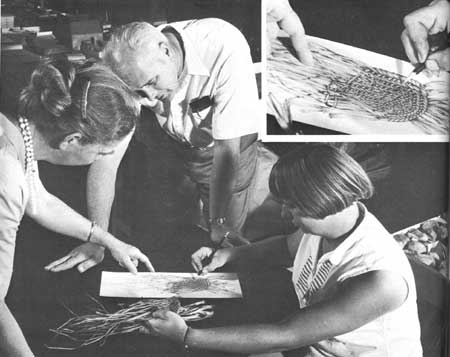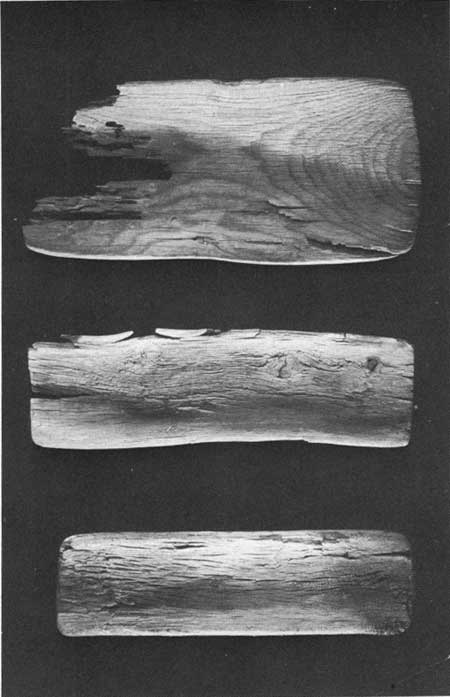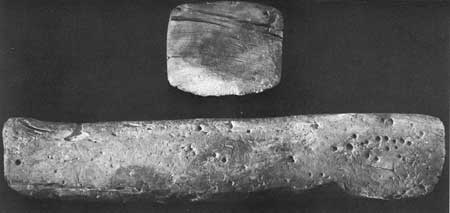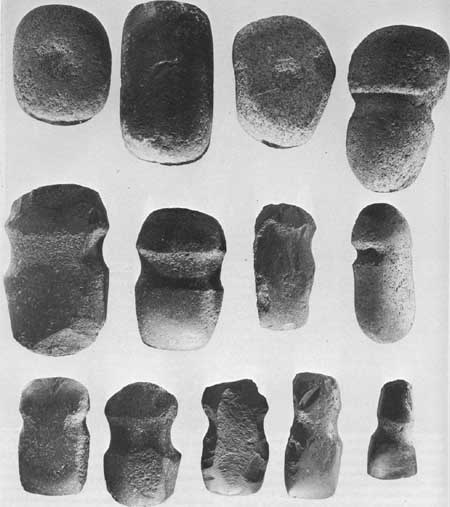|
MESA VERDE
The Archeological Survey of Wetherill Mesa Mesa Verde National Park—Colorado |

|
THE ARCHEOLOGICAL SURVEY OF WETHERILL MESA (continued)
smaller collections
A number of specimens were collected, which, although they do not constitute a large enough body of material for thorough analysis, should be recorded to serve as comparative or supplementary data for other studies. Some of the specimens which are of interest, either because they are unusual or because they are representative, will be discussed briefly.

|
| Drawing textile patterns in the laboratory. |
WOOD
The dry environment of the caves and the comparative lack of disturbance in many of the sites visited were responsible for the collection of more items of perishable material than is usually the fortune of a survey archeologist. Among such items were 16 digging sticks, whole or fragmentary, from 9 sites. Four are illustrated in figure 114. They are of two types: a straight dibble with a short beveled point, and a spatulate hoe or weeder with a third to a half of the distal end a flattened blade. The hoes are carefully worked, with a round knob carved at the proximal end, and average 3.6 feet in length. Blades averaged 0.2 foot wide. That straight dibbles were used for planting and the bladed tools for weeding is recorded ethnographically for Cochiti (Lange, 1959), Walpi, San Ildefonso, Santa Ana, and the Navajo (Gifford, 1940). The stick at the top of figure 114 was found placed above a viga in Site 1193, a cliff dwelling at the head of Long Canyon. Porfirio Montoya of Santa Ana, who examined our specimens in the laboratory, said his father used a similar hoe and placed it in the ceiling timbers of the house when he came in from the fields. The second item from the top of figure 114 was part of a cache of six sticks found with the jar in figure 58. Broken hoes were frequently used as lintel sticks. Figure 115 shows one in place at Site 1221 in the West Fork of Long Canyon.

|
| Figure 114—Digging sticks. From top to bottom: oak hoe from Site 1193, serviceberry hoe from Site 1187, mountain-mohogany hoe from Site 1218, serviceberry dibble (proximal end missing) from Site 1322 (cat. #'s from top 12045/702, 12038/702, 12044/702, 13483/702). |

|
| Figure 115—Doorway with digging stick used as false lintel or stop for slab door. Site 1221. |
Three shallow wooden dishes were collected and are illustrated in figure 116. The dish at the top, from Site 1370, measures 0.5 by 1.1 feet and was made of Douglas fir. All surfaces have been carefully sanded. The center dish, from Site 1892, was made by splitting an unidentified species of pine and hollowing the inside. The inside and the ends were ground but the exterior was unfinished. The dish at the bottom of the figure, made of pinyon, shows evidence of sanding on both sides and the corners and cutting-marks at the ends. It was found in a metate bin (fig. 117) at Site 1365. Though found lying the long way of the bin beside the metate, it almost exactly fits a depression at the foot of the metate and served the purpose of collecting the ground meal.

|
| Figure 116—Wooden dishes. From top to bottom: cat. #13520/702 from Site 1370, cat. #17216/702 from Site 1892, cat. #13506/702 from Site 1365. |

|
| Figure 117—Metate bins. Wooden dish in left bin, mano in right bin. Site 1365. |
Also from Site 1365 is the rectangular object shown at the top of figure 118. Made of juniper, it was well sanded, leaving no tool-marks. Three holes 2 to 4 mm. wide were drilled on one edge. The larger hole; to the right in the photo, was drilled from both sides with a coarse drill. The other holes have nearly perpendicular walls. There is a slight depression in the center of the board. To informants from Rio Grande pueblos brought to the laboratory by Florence Ellis of the University of New Mexico, the artifact suggested the head of a cradleboard.

|
| Figure 118—Possible cradleboard part and lapboard (cat. #'s 13504/702 and 13524/702). |
At the bottom of figure 118 is a board of juniper measuring 0.45 by 2.4 feet. The under surface is flat and "planed" or sanded; the upper is irregular but smoothed and with beveled shoulders. Thirty-one pits, averaging 0.2 inch deep, have been drilled at random in the upper surface. The bottoms of some of the pits were coated with pitch. The Indians thought it was a lapboard used in making beads, the small pits to hold blanks of stone or shell in place while the center perforation was drilled. All but the flat under surface of the board was heavily smoke-blackened and it may have had a secondary use as a lintel.
TEXTILES
A detailed analysis of textile material from the survey and excavations is planned for a future publication. Numerous examples of knotted yucca leaves and pieces of yucca cordage were collected from cave sites, but few specimens of weaving were found. Fragments of three baskets, two coiled and one twilled, were collected. One small piece of finely woven yucca fabric was found and one short length of cotton twine. Fragments of four sandals twilled of yucca leaves came from cliff dwellings. One, with a nearly complete set of tie strings, was picked up on the surface at Site 1370 in Bobcat Canyon (fig. 119). Another, from Site 1382, a large cliff dwelling on Long Mesa, has been reinforced by mending with yucca leaves (fig. 120).

|
| Figure 119—Sandal with toe-strings (cat. #13517/702). From Site 1370. |

|
| Figure 120—Mended sandal (cat. #13526/702). From Site 1382. |
STONE
Though all vegetal material is from a Mesa Verde Phase context, the stone represents the entire gamut of Wetherill Mesa prehistory. It was all surface collected from sites of several different phases, but of insufficient quantity to make a significant analysis. The specimens will be used for comparative data in the study of stone from the various Project excavations. Representative samples of chipped stone appear in figure 121. The Milnesand point mentioned in the discussion of phases (p. 88) is third from the right in the top row. The point at the extreme left, middle row, was picked up in front of a unit pueblo in the head of Long Canyon but is not a familiar Anasazi type. I do not know how it would compare with recent Ute projectile points. The second and third from the left, middle row, are typical points of the La Plata and Piedra Phases. The bottom row are the familiar side-notched Pueblo II and III type. Typical full-groove, polished axes and hammers are shown in figure 122.

|
| Figure 121—Pressure flaked tools. (Proveniences and catalog numbers listed left to right, top to bottom: from head of Long Canyon, cat. #17195/702; from Site 1230, cat. #17166/702; from Site 1670, cat. #23471/702; from bottom of Rock Canyon, cat. #13611/702; from Site 1861, cat. #17199/702; from Site 1285, cat. #17162/702; middle row—from Site 1164, cat. #12065/702; from Site 1555, cat. #17109/702; from Site 1664, cat. #17139/702; from Site 1872, cat. #17203/702; from Site 1169, cat. #12069/702; from Site 1230, cat. #12080/702; from Site 1414, cat. #13411/702; bottom row—from Site 1749, cat. #17174/702; from Site 1801, cat. #17181/702; from Site 1600, cat. #17125/702; from Site 1688, cat. #17171/702; from Site 1172, cat. #12066/702; from Site 1155, cat. #12064/702; from Site 1500, cat. #13619/702; from Site 1344, cat. #13326/702; from Site 1106, cat. #13308/702). |

|
| Figure 122—Pecked and polished stone tools. (Proveniences and catalog numbers listed left to right, top to bottom: from Site 1681, cat. #17122/702; from Site 1302, cat. #13335/702; from Site 1321, cat. #13352/702; from Site 1241, cat. #17164/702; middle row—from Site 1320, cat. #13341/702; from Site 1362, cat. #13387/702; from Site 1357, cat. #13384/702; from Site 1193, cat. #12031/702; bottom row—from Site 1365, cat. #13395/702; from Site 1365, cat. #1339/702; from Site 1141, cat. #12029/702; from Site 1448, cat. #13422/702; from Site 1320/702, cat. #13342/702). |
The stone tools in the top row, the first three from the left, have pecked surfaces on the ends and small pecked depressions on the flat surfaces. Morris (1939, p. 128) describes similar artifacts as "pitted rubbing and pounding stones" and believes the pits were provided for a thumb-and-finger grip. He found them commonly on Pueblo I sites but diminishing thereafter. All four found by the survey were from Pueblo III sites. The one on the far left came from a site that also had a Mancos Phase occupation.
BONE
Thirty-five bird bones collected from nine sites were identified by Lyndon L. Hargrave. Except for three bones from three individual turkey vultures from Plank House on Wildhorse Mesa, a probable recent nesting place, all were turkey bones. Four were made into awls and one showed evidence of cooking.
Twenty-six mammal bones from nine sites were studied by Thomas W. Mathews at the Southwest Archeological Center. Identified species were cottontail, gray fox, mule deer, coyote, bobcat, and bighorn. All the worked bone was from a single ruin, Site 1302, a cliff house in Rock Canyon. These specimens were three awls of bobcat ulnae, a perforated coyote tibia, and two worked deer bones. Cottontail was collected at the most sites (four), but bighorn was represented by the largest number of specimens (seven), although six of these came from one site, reducing the significance. Site 1493, a small cave in Rock Springs Canyon, produced Chapin Gray pottery and the bighorn bones. One of the latter from a test trench was burned and probably was a food bone. The site can be assigned to the La Plata or Piedra Phase. All other bones may or may not represent aboriginal food bones. They were collected on the surface and may be the recent leavings of carnivores. Animals definitely associated with the period of occupation are bighorn, coyote, mule deer, and bobcat.
FOOD PLANTS
Food plant remains were collected from 49 cliff dwellings. Most specimens were of corn, but also included were squash and/or pumpkin, gourd, and beans. A full report by Hugh Cutler of the Missouri Botanical Garden will be included in a later publication.
TREE-RING SPECIMENS
Twenty-eight wood specimens from construction timbers in 15 cliff houses were sent to the Tree-Ring Laboratory at the University of Arizona, where they were examined by Robert F. Nichols. Juniper led the list with 13 samples, all undatable, as were the single specimens of serviceberry and cottonwood. The one piece of pinyon, four of the seven ponderosa specimens, and two of four from Douglas-fir were dated (table 9). Dates were checked by Bryant Bannister.
TABLE 9.—Dated wood specimens collected by the survey
| Site | Specimen no. | Form | Species | Date—A.D. Inner Outer |
Location |
| 1448 | MV-525 | Cross section | Douglas-fir | 1179p—1271v | ? |
| (Daniels House) | |||||
| 1221 | MV-526 | Core | Ponderosa | 1183p—1253B | Viga in place, Room 4 |
| 1207 | MV-527 | Cross section | Pinyon | 1064p—1169L | Viga, northmost room |
| 1355 | MV-538 | Cross section | Ponderosa | 1145p—1256vv | On floor, destroyed room south of kiva |
| (Plank House) | |||||
| 1365 | MV-542 | Cross section | Ponderosa | 1126p—1270vv | Collapsed ceiling south room |
| MV-543 | Three-quarter section | Ponderosa | 1059p—1260v | Do. | |
| 1385 | MV-549 | Half section | Douglas-fir | 1199p—1244vv | Ladder landing platform, middle cave |
| (Double House) | |||||
| 1241 | MV-553 | Cross section | Pinyon | 1017p—1238vv | Second kiva from south |
| (Ruin 16) | |||||
| MV-556 | Cross section | Juniper | 1132p—1215L | Third kiva from south | |
| MV-558 | Cross section | Juniper | 1180p—1256R | Do. | |
| MV-566 | Cross section | Juniper | 1188p—1256RL | Room south side of third kiva from south | |
| MV-569 | Cross section | Juniper | 1195p—1256R | Near fifth kiva from south | |
| MV-570 | Section | Juniper | 1055p—l1170vv | Fourth kiva from south | |
| MV-573 | Section | Juniper | 1115—1204vv | Talus below ruin | |
| MV-574 | Cross section | Pinyon | 1151p—1266R | Do. | |
| 1834 | MV-1302 | Cross section | Pinyon | 1812p—1891vv | |
| (Nordenskiold's camp) | |||||
p: Pith ring present. B: Bark present, probable cutting date. v: Outside shows erosion, last ring variable around circumference. vv: Outside shows extreme erosion, last rings very variable. L: Outer surface uniform in texture and color. R: Outer ring constant over significant portion of circumference. | |||||
| <<< Previous | <<< Contents>>> | Next >>> |
archeology/7a/survey8.htm
Last Updated: 16-Jan-2007